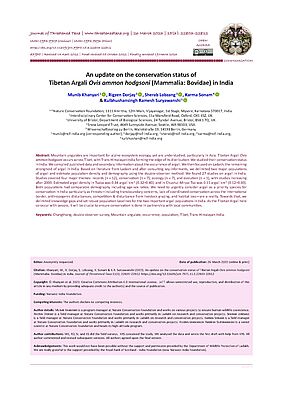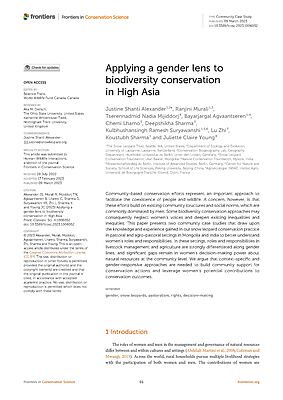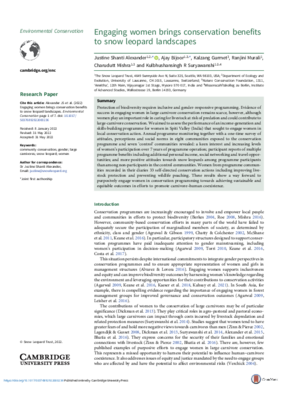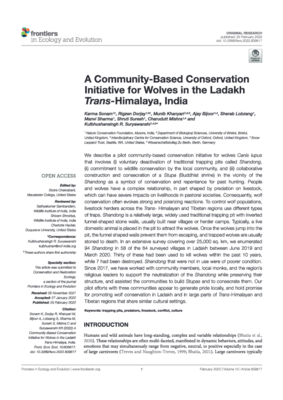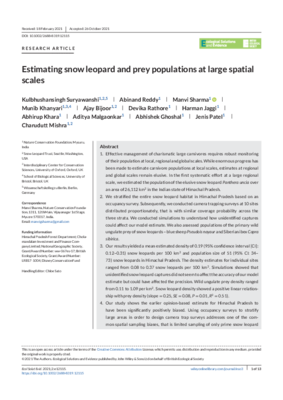
Kulbhushansingh Suryawanshi, Ph.D.
Ecology
Nature Conservation Foundation, Mysore
from September 2021 to February 2022
Born in 1985 in Malkapur, India
Studied Zoology, Botany, and Computer Science at Dr. Babasaheb Ambedkar Marathwada University, Wildlife Biology and Conservation at the National Centre for Biological Sciences, and Ecology and Conservation at Manipal University
Fellowship
College for Life Sciences
Arbeitsvorhaben
Snow Leopard on Thin Ice: Ecology and Human Dimensions of Conservation in the Indian Trans-Himalaya
The Hindu Kush Himalaya Mountains are the water towers of Asia. I am interested in the many facets of nature conservation in the Indian trans-Himalaya, a vast but little-known region hidden in the rain shadow of the Himalayas. The charismatic and elusive snow leopard is a flagship and emblem for the conservation of this region. I want to understand how ecological research over the past five decades influenced the trajectory of conservation policy and practice in this region. Early efforts of conservation in this region followed the old idea of focussing on the creation of large protected areas. By the early 2000s, however, conservation efforts started diverging from the mainstream discourse, with new ideas that were more inclusive and people-centric. This led the Indian Ministry of Environment and Forest to launch Project Snow Leopard with the stated goal to promote conservation in the larger landscape beyond protected areas through participatory policies and actions. What role did ecological research play in this change in a national level conservation policy?Over the past few years, conservationists across the distribution range of the snow leopard have been confronted with the question "how many snow leopards are there in the world?" This was partly sparked by the International Union for Conservation of Nature's (IUCN) decision to down-list snow leopards from the category of Endangered to Vulnerable in its Red List of species. But how do we reconcile this idea of species-focussed conservation with the ideas of landscape-focussed conservation as envisaged by Project Snow Leopard? My research will focus on building an understanding of the diverse and interwoven strands that have led to the specific current practice of conservation in the Indian trans-Himalaya and its resonance with emerging global discourse on conservation as it tries to grapple with ideas of community-based conservation, neo-protectionism, and market-based solutions.
Recommended Reading
Suryawanshi, Kulbhushansingh R., Saloni Bhatia, Yash Veer Bhatnagar, Stephen Redpath, and Charudutt Mishra (2014). "Multiscale Factors Affecting Human Attitudes toward Snow Leopards and Wolves." Conservation Biology 28, no. 6: 1657-1666. https://doi.org/10.1111/cobi.12320.
Suryawanshi, Kulbhushansingh R., Stephen M. Redpath, Yash Veer Bhatnagar, Uma Ramakrishnan, Vaibhav Chaturvedi, Sophie C. Smout, and Charudutt Mishra (2017). "Impact of Wild Prey Availability on Livestock Predation by Snow Leopards." Royal Society Open Science 4: 170026. https://doi.org/10.1098/rsos.170026.
Suryawanshi, Kulbhushansingh R., Munib Khanyari, Koustubh Sharma, Purevjav Lkhagvajav, and Charudutt Mishra (2019). "Sampling Bias in Snow Leopard Population Estimation Studies." Population Ecology 61, no. 3: 268-276. https://doi.org/10.1002/1438-390X.1027.
Kolloquium, 26.10.2021
Kann der Schneeleopard und sein Habitat in den Bergen Asiens gerettet werden?
Der Schneeleopard (Panthera uncia) ist einer von nur fünf lebenden Vertretern der Gattung der Großkatzen auf der Welt. Er lebt den Hochgebirgen Asiens – im Himalaya, Karakorum, Hindukusch, Pamir, Tian Shan, Kunlun und im Altai. Der Schneeleopard ist zum Symbol für den Schutz der Berge und ihrer Natur geworden. In diesen Bergen sind einige der ökologisch vielfältigsten Lebensräume auf diesem Planeten beheimatet. Ein Viertel der Menschheit ist unmittelbar abhängig von den Flüssen, die hier entspringen. In meinem Vortrag gehe ich verschiedenen Aspekten nach – der Wissenschaft der Ökologie und den menschlichen Dimensionen des Naturschutzes, die zur derzeitigen Praxis des Naturschutzes in den asiatischen Hochgebirgen geführt haben.
Ich stelle die Ökologie des asiatischen Hochgebirges vor, seine wichtigsten Tier- und Pflanzenarten und erörtere die Herausforderungen für ihre Erhaltung anhand von Beispielen verschiedener Naturschutzansätze: Ansätze, die gebietsbezogen, gemeinschaftsbezogen, marktbezogen sind oder auf den Leistungen des Ökosystems basieren. Die entscheidenden Fragen, die es zu diskutieren gilt, sind folgende: Wie viele Schneeleoparden gibt es weltweit? Und ist das von Bedeutung? Ist die Weidewirtschaft – die vorherrschende Landnutzung in dieser Region – nützlich oder schädlich für den Schutz des Schneeleoparden? Wie sollten wir uns zum Schneeleoparden (und zur Natur im Allgemeinen) positionieren? Einigen der weit verbreiteten Annahmen möchte ich Daten und Forschungsarbeiten gegenüberstellen und über meine Erfahrungen als Naturschützer sprechen; gleichzeitig reflektiere ich meine Rolle als Wissenschaftler und Naturschützer, der versucht, die Gegensätze auszugleichen, die manchmal zwischen Umweltschutz und Gesellschaft entstehen.
Abendkolloquium , 16.12.2021
Is my Cashmere Scarf Strangling the Snow Leopard?
How do we conserve rare and endangered species in a globalized world? The snow leopard was thought to be an elusive carnivore that lived far from human influence in the remote high mountains of Asia, but its fate and the fate of many other rare animals of this region are entangled with one of the world’s finest fabrics: cashmere. In this talk, Kulbhushansingh Suryawanshi describes how the growing demand for cashmere is affecting wildlife conservation in this region. What does it mean for the traditional nomadic herders who live in these harsh landscapes and produce cashmere? And what can we do about it?
Publikationen aus der Fellowbibliothek
Suryawanshi, Kulbhushansingh (Bangalore, 2024)
Suryawanshi, Kulbhushansingh (Oxford [u.a.], 2024)
Can livestock grazing dampen density-dependent fluctuations in wild herbivore populations?
Suryawanshi, Kulbhushansingh (Lausanne, 2023)
Applying a gender lens to biodiversity conservation in High Asia
Suryawanshi, Kulbhushansingh (Tamil Nadu, 2023)
Suryawanshi, Kulbhushansingh (Cambridge, 2022)
Engaging women brings conservation benefits to snow leopard landscapes
Suryawanshi, Kulbhushansingh (Lausanne, 2022)
A community-based conservation initiative for wolves in the Ladakh Trans-Himalaya, India
Suryawanshi, Kulbhushansingh (Hoboken, NJ, 2021)
Estimating snow leopard and prey populations at large spatial scales
Suryawanshi, Kulbhushansingh (Lausanne, 2021)
Suryawanshi, Kulbhushansingh (Hoboken, NJ, 2019)
Sampling bias in snow leopard population estimation studies
Suryawanshi, Kulbhushansingh (London, 2017)
Impact of wild prey availability on livestock predation by snow leopards
